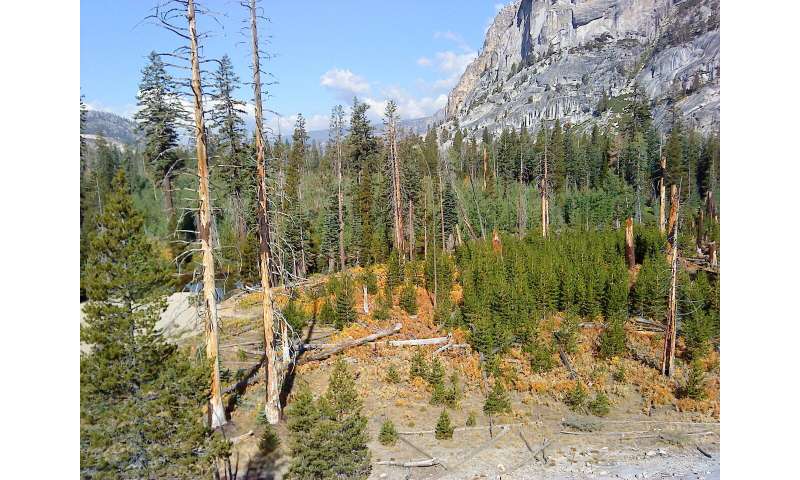Story Tips: Shuffling atoms, thinning forests, fusion assembly and nuclear medicine

Neutrons—Deuterium shuffle
Scientists have found a new method to strategically add deuterium to benzene, an aromatic compound commonly found in crude oil. When applied to the active ingredient of drugs to incorporate deuterium, it could dramatically improve the drugs' efficacy and safety and even introduce new medicines.
To validate the method, which was published in Nature, a team led by W. Dean Harman of the University of Virginia worked with Xiaoping Wang at the Oak Ridge National Laboratory's Spallation Neutron Source. Wang successfully verified the exact position of deuterium atoms that resulted from the selective deuteration of benzene molecules using single crystal neutron diffraction.
"Because the high sensitivity of neutrons to hydrogen and its deuterium isotope, we were able to quantitatively assign not only the positions of the deuterium atoms at the atomic level, but also determine precisely how many were added on each side of the benzene molecule," Wang said. "This is important in designing new therapeutic drugs."
Media Contact: Sara Shoemaker, 865.576.9219, shoemakerms@ornl.gov
Image: https://www.ornl.gov/sites/default/files/2020-06/20-G00484_Wang_ST.png
Caption: Using the single-crystal diffractometer TOPAZ, Oak Ridge National Laboratory confirmed the exact position of deuterium atoms from selective deuteration of benzene molecules. Credit: Jill Hemman/Oak Ridge National Laboratory, U.S. Dept. of Energy
Ecology—Thinning forests
A multi-institutional research team found that changing environmental conditions are affecting forests around the globe, leading to increasing tree death and uncertainty about the ability of forests to recover.

"There's a lot of nuance just in the carbon dioxide response," said Anthony Walker of Oak Ridge National Laboratory who contributed carbon dioxide analyses for the study published in Science. "We are examining the many tradeoffs and feedbacks. For instance, elevated carbon dioxide can spur tree growth while also increasing the risk of mortality associated with faster growth rates."
The study concluded that pervasive shifts in forest vegetation are likely to accelerate in the future.
Media contact: Kim Askey, 865.576.2841, askeyka@ornl.gov
Image: https://www.ornl.gov/sites/default/files/2020-06/fire%20regrowth.jpg
Caption: Pine trees in the Tuolumne Valley of Yosemite National Park show the effects of drought and fire. Credit: Anthony Walker/Oak Ridge National Laboratory, U.S. Dept. of Energy
Image: https://www.ornl.gov/sites/default/files/2020-06/p1060209.jpg
Caption: Fraser firs are affected by the balsam woolly adelgid atop Mount LeConte in the Great Smoky Mountains National Park. Credit: Anthony Walker/Oak Ridge National Laboratory, U.S. Dept. of Energy
Fusion—ITER assembly begins
ITER, the world's largest international scientific collaboration, is beginning assembly of the fusion reactor tokamak that will include 12 different essential hardware systems provided by US ITER, which is managed by Oak Ridge National Laboratory.

The systems include superconductors for the toroidal field magnet system and ORNL-developed pellet injection technology for plasma fueling and performance. These critical components will help ITER achieve its mission to demonstrate a self-heated, burning plasma and 500 megawatts of fusion power.
The 60-foot-tall central solenoid magnet, also fabricated under ORNL management, is considered the "heart of ITER" because it will initiate and drive plasma current inside the tokamak.
"The start of ITER tokamak assembly is a momentous milestone for the project and makes the fusion community—at Oak Ridge and around the world—excited for the future," Kathy McCarthy, US ITER project director, said.
The first shipment of central solenoid modules to ITER, located in southern France, will begin later this year.
Media contacts: Lynne Degitz, 865.466.6383, degitzlk@ornl.gov and Laban Coblentz, +33 6 14 16 40 85, laban.coblentz@iter.org
Image: https://www.ornl.gov/sites/default/files/2020-06/Photo%203.%20Base%20over%20pit_0.jpg
Caption: The 1250 ton cyrostat base is positioned over the ITER tokamak pit for installation. This base is the heaviest lift of tokamak assembly. Credit: ITER Organization
Isotopes—Improved process for medicine
Oak Ridge National Laboratory researchers have discovered a better way to separate actinium-227, a rare isotope essential for an FDA-approved cancer treatment.
To produce Ac-227, researchers recover radium-226 from obsolete medical devices and fabricate it into targets that are irradiated in the High Flux Isotope Reactor. Ac-227 is then separated from the targets and purified.

Initially, researchers used caustic solution to dissolve targets, but recently they developed an approach using an acidic solution.
"From that one simple step, we increased actinium yield, minimized waste production, optimized our processing timeframe and made it easier to recycle radium," said ORNL's Roy Copping. "This is an important project for the lab, and it's of enormous benefit to mankind."
ORNL began producing Ac-227 in 2017 and has a 10-year contract with U.S. DOE's Isotope Program and Bayer. Radium-223 dichloride, derived from Ac-227, is the primary ingredient in Bayer's Xofigo prostate cancer drug.
Media contact: Kristi Nelson Bumpus, 865-253-1381, bumpuskl@ornl.gov
Image: https://www.ornl.gov/sites/default/files/2020-06/Ac227%201.jpg
Caption: Ra-226 pellets are loaded in a target for irradiation in ORNL's High Flux Isotope Reactor. Credit: Oak Ridge National Laboratory, U.S. Dept. of Energy
Image: https://www.ornl.gov/sites/default/files/2020-06/Ac227%202_0.jpg
Caption: Solid radium sulfate sits in the bottom of a flask during the recovery process. Credit: Oak Ridge National Laboratory, U.S. Dept. of Energy
More information:
Smith, J.A., Wilson, K.B., Sonstrom, R.E. et al. Preparation of cyclohexene isotopologues and stereoisotopomers from benzene. Nature 581, 288–293 (2020). doi.org/10.1038/s41586-020-2268-y
Pervasive shifts in forest dynamics in a changing world
BY NATE G. MCDOWELL, CRAIG D. ALLEN, KRISTINA ANDERSON-TEIXEIRA, BRIAN H. AUKEMA, BEN BOND-LAMBERTY, LOUISE CHINI, JAMES S. CLARK, MICHAEL DIETZE, CHARLOTTE GROSSIORD, ADAM HANBURY-BROWN, GEORGE C. HURTT, ROBERT B. JACKSON, DANIEL J. JOHNSON, LARA KUEPPERS, JEREMY W. LICHSTEIN, KIONA OGLE, BENJAMIN POULTER, THOMAS A. M. PUGH, RUPERT SEIDL, MONICA G. TURNER, MARIA URIARTE, ANTHONY P. WALKER, CHONGGANG XU
SCIENCE, 29 MAY 2020
Science 29 May 2020:
Vol. 368, Issue 6494, eaaz9463
DOI: 10.1126/science.aaz9463
science.sciencemag.org/content/368/6494/eaaz9463
Sara C. Shoemaker
Communications and Media Relations
Oak Ridge National Laboratory
1 Bethel Valley Road (P.O. Box 2008)
Oak Ridge, TN 37831
Office: 865-576-9219
Email: shoemakerms@ornl.gov | Web: www.ornl.gov
Twitter: @ORNL
Provided by Oak Ridge National Laboratory